CLASS CUTS WON’T CUT IT
Chancellor Mark Rocha resigns after slashing courses

CLASS CUTS WON’T CUT IT
Chancellor Mark Rocha resigns after slashing courses
COVID-19 may break norms but not The City’s spirit
 City College of San Francisco | Spring 2020
City College of San Francisco | Spring 2020
Class cuts impact hundreds of educators’ careers including the chancellor’s
Family-run Mission Center eatery celebrates 12 years of Cafe de la Mission

A student navigates a campus not built for her
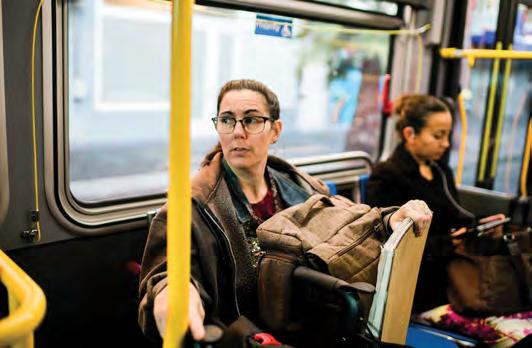
A car-free Market Street changes the downtown experience


Throw Down. Get Up. Repeat.
Judo and jiu jitsu club camaraderie reflects the City College experience

Editor in Chief Daniel Murphy
Managing Editor Ashley Ornelas
Content Editor Meyer Gorelick
Design Director Jasmine Castillo
Photo Editors Fran Smith
Emily Trinh
Illustrator Jennifer Yin
Staff photographers ask people for their silver lining during the shelter-in-place

Staff Writers & Photographers
Eleni Balakrishnan
Abraham Davis
Diana Guzman Flores
Kevin Kelleher
Steven Ray
Yujin Lim
Carlos da Silva
Emily Huston
Adviser Jessica Lifland
On the Cover: Illustration by Jennifer Yin and Bobby Ramirez for Etc Magazine Artists’ interpretation of a coronavirus-infected cell that caused the COVID-19 pandemic, resulting in the shutdown of in-person instruction at City College.

Back Cover: Design by Sergey Kyryliuk, Emerge Studio/Design Studio Practicum Visual Media Design Department.
About Etc Magazine: Etc Magazine is an award-winning student publication. It is written, edited, photographed, illustrated, designed, produced and distributed by students enrolled in the Journalism program at City College of San Francisco.
The magazine is devoted to fair and objective reporting. We cover the important issues facing the college, its students, faculty, staff, administration and the surrounding community. Any opinions expressed in the publication represent the views of the students who authored them. Etc does not purport to represent the views of the school’s administration. The magazine comes out twice a year — once in the spring and again in the fall.
“Sorry Dan, I’m just too slow to keep you on the clock this morning. I hope things turn around soon,” was the last I heard from my manager Tika on Sunday, March 15. I was cut after only two hours of my normal six-hour shift at the Valencia Street bakery, Craftsman and Wolves. Although still frazzled from the early wake-up call to open the shop, I understood. We had an abysmal $13 in sales for the morning, whereas on a typical Sunday there’s a line out the door and chaos at the coffee bar. Today I was scrubbing baseboards.
It was a glorious day and I was just blocks from City College of San Francisco’s Mission Center. Determined to make the most of my rare day off, I swung around the corner to the acclaimed Flour + Water, eager to grab a slice. Instead, I found the general manager boarding up the windows with plywood. Walking home I witnessed businesses all along Valencia Street doing the same. Our world became a ghost town overnight. COVID-19, swamping the mainstream media for weeks, had just begun to grip San Francisco.
Over the last 18 months, Etc Magazine has led me to fall in love with storytelling through journalism. It is a thrilling cat-and-mouse game between writers, editors, photographers and their subjects. Add to that the rush I get from my personal struggle with the J-train routinely running 18 minutes behind schedule, and you can see how I keep my adrenaline running during a normal semester.
But this semester’s production of Etc Magazine was anything but normal. Nearly derailed by the global pandemic and the ensuing economic downturn, our fast-paced weekly staff meetings came to a screeching halt. Unable to enter our lab, we could not even access our server. Prior to these past few months, I thought Zoom was some kind of cybersex chatroom. Now, it’s how our staff collaborates and problem-solves in lieu of in-person interaction.
With cancelled events, suspended club meetings and no school, our photo-heavy magazine had to be supplemented with illustrations. Staff member Jennifer Yin stepped up to the plate, designing the cover and three illustrations. Jasmine Castillo, Design Director, assembled beautiful spreads and a press-ready magazine — a tedious responsibility to complete remotely. Long hours were logged by Castillo and our design team to lay out this issue, and this publication would not be possible without their extended effort.
In this issue, Meyer Gorelick and Steven Ray dive into the current state of affairs regarding class cuts and their reverberation throughout the City College community in “Death by 1,495 Cuts.” Ray focuses on four part-time instructors who lost a significant portion of their income abruptly and without warning. Gorelick illustrates how the recently ousted Chancellor Mark Rocha failed to uphold City College’s mission to educate and serve the entire San Francisco community.
Through his writing and photography, Abraham Davis explores the camaraderie of judo and jiu jitsu in “Throw Down. Get up. Repeat.” Mixed martial arts is one of the fastest-growing sectors in sports entertainment, and the growth of the City College judo and jiu jitsu club reflects this. Mitchell Palacio has run the club since 1986, and has built a diverse and tight-knit community.
In collaboration with Carlos da Silva, I share the story of “The Unbreakable Nikki Phillips.” It’s a testament to her grit as she navigates City College while dealing with severe osteoarthritis and mental illness. Through the help of the Disabled Students Program Services, DSPS, Phillips overcomes the odds to succeed academically. The story was photographed by Etc alumnus Yujin Lim.
Eleni Balakrishnan’s timely piece, “Transit on an Open Market,” explores what happened when San Francisco banned all personal vehicles from its main downtown thoroughfare. While it benefits the cyclists, public transport commuters and pedestrians, the new ordinance raises questions Balakrishnan addresses. Staff photographer Kevin Kelleher captures car-free Market Street both pre- and post-COVID-19 lockdown.
Much to my delight, former Editor-in-Chief of the publication Emily Huston returns as a guest writer to profile Veronica and Alberto Campos, owners of the Cafe de la Mission, located at Mission Center in “Corazón y Alma.” Staff photographer and Assistant Photo Editor Emily Trinh photographed them just before the COVID-19 fiasco shut down the school. The Campos family has fed first-rate Latin American dishes to City College students, faculty and staff for an admirable 12 years.
With large gatherings on hold, and an empty San Francisco, I have to tip my cap to our staff photographers, Emily Trinh and Kevin Kelleher, for their hustle in the face of the pandemic. Kelleher braved our revered Frida Kahlo Way during the crisis to get photographs of an eerie Ocean Campus.
Without strong editors, our writing lacks discipline and clarity. Managing Editor Ashley Ornelas’ scrupulous eye for grammar and style gives our writing legitimacy—and makes my run-on-sentences lucid. Content Editor Meyer Gorelick has a knack for concise and clean story-telling that is much appreciated by our entire staff. Photo Editor Fran Smith continues her journalism department legacy, adding beautifully-edited photo stories to her portfolio.
Recently, our beloved adviser Jessica Lifland has been thrown to the wolves of fiscal bureaucracy that has overcome our cherished City College. She only learned of her own class cuts last November, while assembling our fall issue late into the night. For an instructor that has dedicated 15 years to City College, this was disrespectful and disgraceful in the eyes of so many of us who have been fortunate enough to learn from her over the years.
In our pandemic-ridden brave new world, I can confidently say Jessica Lifland will not let Etc Magazine go down the rabbit hole of class cuts without a fight, nor without that New York fire in her eyes.
Our responsibility as journalists to deliver a truthful and compelling narrative becomes all the more vital in a time of crisis and uncertainty. I must commend our staff for pushing through adversity to publish this latest issue of Etc Magazine. It was not easy. Wash your hands. Until next time, San Francisco.
Special Thanks:

Etc Magazine would like to thank Colin Hall, John Seckman and Lorraine Leber’s design students for submitting their back cover promo ad designs; our Mission and Ocean Campus Media Center lab technician Manuel Saballos and our printer Sanjay Sakhuja with DPI Printing.
We are grateful to the following companies for their genorosity—without which this issue created remotely under shelter-in-place orders would not have been possible: Adobe, Associated Press, Camera Bits, Google for Educators and Zoom.



 Daniel Murphy, Editor in Chief
Daniel Murphy, Editor in Chief

 Profiles by Steven Ray
Profiles by Steven Ray
In the name of budget balancing, Chancellor Mark Rocha cut over 1,400 classes and 300 teaching positions over the past three years, yet City College of San Francisco still finds itself in financial turmoil.
Rocha, who resigned on March 16, targeted part-time teachers by either reducing their course loads or eliminating their positions entirely, and made unilateral decisions without student, faculty or community input, gutting and sometimes eliminating entire departments.
Days before Thanksgiving, on the eve of registration for the spring 2020 semester, Rocha’s administration eliminated 345 classes to address a $13 million budget deficit. This “midnight massacre” was the latest in a series of cuts that rocked the City College community.
Supervisor Shamann Walton attempted to restore those classes with a $2.7 million bridge fund, but Rocha wrote an email to the Board of Supervisors urging them to allow administrators to
handle budget issues internally. He framed the class cuts as part of a long-term plan.
Due to Rocha’s email, the bridge fund fell one vote short of a veto-proof majority among the Board of Supervisors, and Mayor London Breed struck it down on Valentine’s Day.
“Using General Fund Reserve dollars as a band-aid for long-term structural problems does not help City College,” Breed wrote in her veto message.
declined to comment on why he resigned, citing that they are not allowed to discuss personnel issues.
His departure came after a series of harmful actions toward the college he was appointed to guide and serve, including the midnight massacre and his rejection of bridge funds.
The entire metal arts department was cut, all but two of 54 older adult department courses were wiped out, the
These cuts, as did the hundreds made before the midnight massacre, disproportionately impacted part-time faculty, many of whom lost their healthcare benefits and/or their livelihoods. The lack of forewarning left teachers like Anita Toney, Anthony Ryan, Kari Orvik and Dierdre White hurt and reeling. Steven Ray profiles these four instructors who were impacted, in the story below.
Although the spring semester cuts were framed as part of a thought-out plan, nothing was shared with faculty or students and the cuts were pushed through at the last minute.
She said the problem requires a more long-term solution.
Rocha’s solution, referenced in his email, never came to fruition. In March, the City College Board of Trustees approved a $340,000 resignation settlement to be rid of him once and for all.
“I will miss guiding the College through its challenges, but believe this is the right time for me to prioritize my family who needs me,” Rocha said in a press release after his resignation.
The college and the Board of Trustees
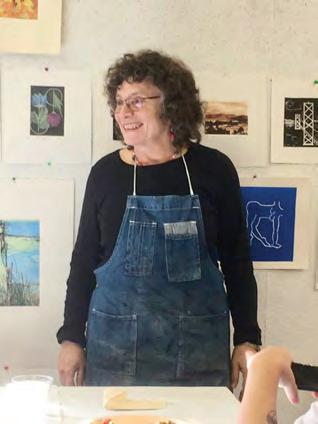
Anita Toney invested 40 years of her life in teaching art, first at San Francisco Community College and then at City College of San Francisco when the two merged in 1990. Her career evaporated on Nov. 20, 2019 when she was among dozens of part-time faculty cut loose with no warning.
“One of my students sent me an email saying that she could not find my class on the online schedule. This was very peculiar as days before, it was there,” she writes via email. Toney first thought it was a computer glitch. Later that day she found out through a conversation with her department chair that the cut was real.
Despite making a 12% reduction in its class schedule, cutting 863 classes for the 2019-20 academic year last January, City College had a projected
engineering department was reduced by 40%, and 43 art department classes were axed. Part-time instructors were hit especially hard.
“What they want to do is be in the classroom being really good teachers. Having to just fight to get to the starting line to do that is really taking a toll on our morale,” says AFT 2121 President Jennifer Worley.
Many instructors aren’t just losing morale, but losing their jobs entirely. Despite their fight, some didn’t make it to the starting line at all this spring.
$13 million shortfall heading into the registration period for the spring 2020 semester, according to the San Francisco Examiner. The school administration chose to eliminate that shortfall by cutting faculty salaries and benefits.
Just days before Thanksgiving, and the day before spring registration opened, the school cut an additional 345 classes, without warning the City College community nor consulting its 46 academic chairs. The cuts were a gut punch, hitting part-time faculty especially hard.
“I was outraged,” Toney says. “The unprecedented last-minute massive cut was a blow for me and my students. I could not believe it was really happening. Many of my fall students had planned to continue with a second semester and were quite devastated.” She says she has no way to replace the lost income.
Art Department Chair Anna Asebedo recalls the day she had to break the news
Even the Department Chairperson Council, which must be consulted before any change to curriculum, wasn’t given any warning. It was a clear breach of standard procedure.
Worley says AFT 2121 knew that the shortfall existed when the spring budget was proposed. They spoke to the administration about it, but their warnings fell on deaf ears.
“The big problem with the cuts from our perspective: A: was that they happened. B: that they were completely planned. They were foreseeable but presented as unforeseeable. And then C: that they were done in such a targeted way,” Worley says.
“It was one of the hardest conversations that I’ve ever had. It’s not how you envision the end of a 40-year career.” — Anna Asebedoto Anita Toney, “It was one of the hardest conversations that I’ve ever had. It’s not how you envision the end of a 40-year career.”
She believes the administration chose to wait to address the deficit until the final hour and made cuts in an inequitable way, without any stakeholders at the table.
“They created a crisis, and then at the last minute targeted programs that they wanted to get rid of.”
Months before these latest cuts, Rocha’s administration got in hot water for another last-minute proposal, this one intended to line pockets atop the academic hierarchy. They proposed six-figure raises for administrators this past fall. In many cases the pay increases were over 100% higher than the previous year.
“I’m appalled, I’m outraged and I’m angry,” student Claudia Anderson told the Board of Trustees at a meeting in September 2019. “I don’t object to administrators getting a raise. I object to the way it’s not transparent—and the amount.”
In the end the raises were not approved. Yet the fact that they were slipped into the proposed budget at the last minute while part-time teachers were losing their jobs and benefits upset many City College community members.
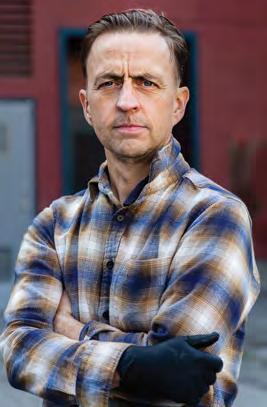
Ryan,
Multiple department chairs say it is unfair and incorrect to chalk up the deficit to teacher salaries, when enrollment is paramount to funding, and eliminating programs limits the amount of courses students can sign up for.
“We’re funded by the state based on our enrollment,” Worley says. “Cutting classes, cutting faculty, that means we’ll have less enrollment,” which means less funding.
up from scratch.”
This wasn’t the first college where Rocha drew the ire of faculty and students. In 2014, he stepped down as president of Pasadena City College, after receiving two votes of no confidence from faculty there, and one from the Academic Senate, as reported by the Los Angeles Times. Pasadena City College faculty cited his failure to consult with them regarding major decisions.
Enrollment dropped nearly 13% during his tenure there.
“An analogy if you were talking about your personal finances would be: well, my commute is really expensive, so I’m just gonna go to work two days a week,” she adds.
Enrollment went down about 7% for the spring semester.
Worley says eliminating classes is an unacceptable solution, “We want to maintain full programs ... not shrink them down and then have to put the resources back into building them all
A lonely washout booth sits in the former screen printing room at Fort Mason, waiting for students who can no longer make use of it. Much more is now stored away, gathering dust.
The screen printing class was taught by Anthony Ryan, one of 107 part-time faculty members who were impacted by the cuts. Ryan lost his only class at City College. Due to the timing, he didn’t have an opportunity to make up the difference by being hired to teach at another school.
Ryan was brought on in 2015 to create the Screen Printing program at Fort Mason Center. He and colleague Robin Kaneshiro dedicated months to building the studio from the ground up, for no pay. They acquired equipment, worked with Buildings and Grounds to build print stations and with Disabled Students Programs and Services, DSPS, to improve accessibility for disabled students.
He taught Beginning Screenprinting and Intermediate Screenprinting for seven semesters in addition to teaching a summer printmaking class and continuing education classes in the studio. His classes were popular, filling up every semester with additional students being waitlisted. Ryan was a finalist for a full-time position in 2018.
Thinking of all the effort put in to get the class up and running, Ryan says of the cancellation: “It is just a very cold-hearted thing to
Despite this, he was brought on in 2017 as chancellor at City College, when the Board of Trustees voted 6-1 to appoint him, ignoring vocal opposition from AFT 2121. He had more experience than other candidates and trustees felt that he had learned from his mistakes and was prepared to lead City College.
Less than three years later, the Board reversed course, this time voting 6-1 to approve his resignation settlement. Rocha received one year’s salary and benefits, six months less than he was entitled to, and an additional $35,000 in unused vacation pay and compensation for certain unspecified expenses. The agreement means neither
do to professionals who are committed to the institution.”
“It was more than a job for me,” he adds, “To be able to donate my time and my expertise and to offer free classes and screen printing, in the city that I live in. What can be better?”
His wife had to take on more hours at her job in order to help cover expenses after his class was cut.
Ryan feels that City College is losing something special with these cuts. “It represents decades of people investing their time and energy into building this thing, you know, that’s important to the community. And it feels like that’s being squandered,” he says.
Constantly being devalued by the administration, “It just kind of wears you down,” Ryan adds.
The printmaking class gave him stability. He could count on this one class that he really loved.
“I was panicked, because I was counting on both the health insurance and the salary.”
— Kari Orvik
party can file suit against the other in the future.
City College will be paying Rocha and a long-term interim chancellor for the next year as it grapples with its significant financial issues.
City College’s underfunding dates back to the accreditation crisis that began in 2012. Former vice president of the Academic Senate and Department Chair Council Madeline Mueller has been music department chair for 35 years and has seen administrations and crises come and go. Mueller says this current budgetary purgatory the college finds itself in began when the Accrediting Commission for Community and Junior Colleges, ACCJC, commenced a five-year attack on City College, which nearly resulted in its closure.
Mueller is not alone in saying that the accreditation crisis was a first attempt at forcing City College to abandon its mission and become a junior college. She believes recent cuts made by Rocha’s administration reflects a similar hostility to the community college model that is trickling down from the state level.
In 2013, the ACCJC announced that they would revoke City College’s
accreditation the following year. Mueller says they fabricated an excuse to come in and threaten accreditation.
The action against City College was the most egregious example of a pattern of harmful behavior, as the ACCJC had imposed sanctions on 60% of California’s Community Colleges.
The ACCJC faced scrutiny from the local
To make up for his lost income, Ryan wants to offer workshops on his own. To that end, he’s taking a small business course online at—you guessed it—City College.
His studies will be put on hold though, as all business department courses have been removed from the summer class schedule.

For the fall 2019 semester, lab hours in the photography department were cut so severely that Kari Orvik, a part-time instructor and lab supervisor, lost her health insurance. When the sudden late-November round of cuts hit, she lost her job.
Orvik was hired in 2017 to teach Beginning Photography after being a student in the photography department from 2000-2004. She also worked as a lab supervisor. Additionally, she taught self-portraiture and introductory design classes. In the spring of 2019, one of her classes was cut, but she was able to keep her benefits through her work in the lab. The following fall, her lab hours were cut enough that she lost her eligibility for benefits.
When the spring 2020 schedule came out, Orvik was set to teach two beginning photography classes in addition to being a lab supervisor, which would be enough to renew her benefits.
During this time, she paid $650 a month for continuation of her healthcare through COBRA, as she was under the impression
to the federal level and was immediately hit with three lawsuits from faculty, students and San Francisco City Attorney Dennis Herrera.
Herrera argued in his injunction that the commission allowed political bias to influence their decision. Several members of the commission and ACCJC President Barbara Beno were supporters of the
that she would be eligible for healthcare in the spring.
Then the week before Thanksgiving, her entire spring schedule got wiped out. She was told that her classes had to be given to teachers with more seniority.
“At first, I was panicked, because I was counting on both the health insurance and the salary. But, then I was pissed. I was really angry at the timing of it. This was something that had been coming down the line that was going to impact so many people and they waited that long to let people know.”
As with Ryan, the timing didn’t afford Orvik the opportunity to apply for teaching jobs elsewhere.
Providing a view into the lives of part-time teachers, City College Teachers Union AFT 2121 President Jennifer Worley says “the thing that was so egregious, just from the point
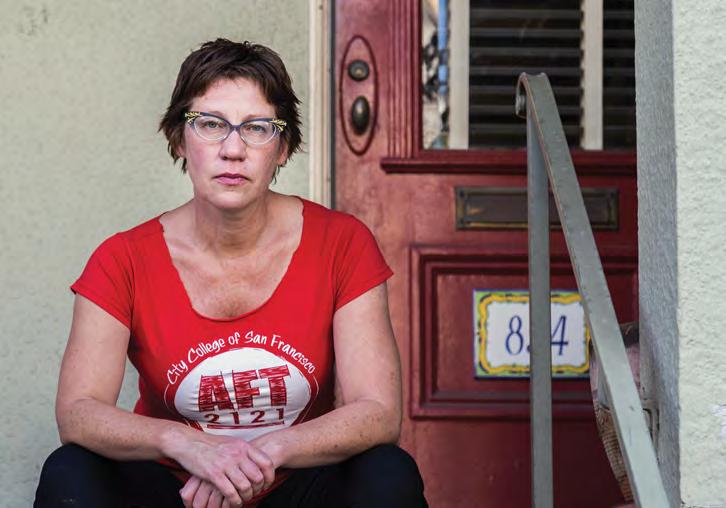 Kari Orvick taught in the Photography department until she was impacted by the cuts. (Kevin Kelleher/ Etc Magazine)
Kari Orvick taught in the Photography department until she was impacted by the cuts. (Kevin Kelleher/ Etc Magazine)
Student Success Task Force, a statewide initiative to shift schools from the community college model to the junior college model, limiting college access to students who aren’t seeking to transfer to a four-year institution. City College is the epitome of a community college, serving older adults, English as a second language students, full-time workers and various lifelong learners.
In January 2017, the ACCJC announced that City College would retain its accreditation, but the damage had already been done.
Enrollment dropped by nearly a third in those five years, from 83,401 in 2011-12, to 58,239 in 2016-17. Due to the financial model for funding of community colleges that existed in California, this took a significant toll on state funding for City College. It dipped 9% in the first year of the accreditation crisis alone.
A new funding formula was implemented by the California Community College State Chancellor’s office in 2019.
The new Student Centered Funding Formula from the state allocates 70% of funding based on enrollment, 20% based on service to low-income students, and 10% based on student success in terms of achieving degrees and transferring to four-year schools.
Shifting the emphasis from enrollment to additional criteria poses a significant challenge to City College. It limits funding for non-credit classes and punishes the school for serving community members who are not seeking transfers, a large part of the student population at City College.
The formula’s calculation for low-income students is based on qualification for Pell Grants, and doesn’t take into account the cost of living in San Francisco. City College students may be scraping for rent, but they don’t fit the state’s definition of low-income. A coalition of Bay Area community colleges are working to amend this part of the formula.
Giving extra funding to schools for serving low-income students should be an incentive, not a punishment, and at the K-12 level in California it is.
of view of workers, was that this happened in late November. We would have gotten our spring class schedule in late September or October, so that we know what we’re teaching.”
Based on this understanding, teachers would accept or turn down offers to teach additional classes at other institutions. Because of the timing of these cuts, it “was too late to get other work. They suddenly had the rug pulled out from under them, and in some cases, it meant they lost their health insurance and lost their kid’s health insurance, so that meant they were really suffering,” said Worley.

Orvik had changed careers from the nonprofit world to photography because City College offered her the chance to go to school while working full time. It allowed her an affordable and accessible way to explore and develop her creative potential.
To be able to return as an instructor “is really powerful,” she says. “It was something that I was really looking forward to being able to do for a long time.”
Orvik has a lot to give back, as do the other instructors at City College. “They’re dedicated to their students … and it’s really a shame,” she says.
Orvik has supported herself through teaching, exhibiting her fine art and growing her portrait business with private commissions in an effort to replace some of her lost income, although that work is unpredictable. Teaching had given her a
“They say ‘we’re funding you 100% but if you serve lots of low-income students you’ll get a little more,’ but for community colleges, they say, ‘well if you don’t serve lots of low-income students we’ll fund you less,’” says Worley.
To increase enrollment, the Free City program was implemented in 2017. There is a misconception that this program has contributed to the current financial crisis, when in fact, the program is entirely funded by an annual allocation from San Francisco’s general fund.
Enrollment has only increased to about 62,000 students since the program was
first implemented, a far cry from the robust enrollment of 90,000 the school had 10 years ago.
Stability funding from the state was put in place as a buffer to the financial impact of the accreditation crisis, but that ran out in 2017.
Trustee John Rizzo says the debacle
way to cover her basic expenses. She expressed dismay at the loss of that revenue for artists, allowing them to both cover their expenses and have an opportunity to share their expertise.
The Bay Area is a visually-oriented nexus of art, media and technology, but the school’s place in it seems to be lost on the administration. Their decision to remove art classes from the curriculum “is a disconnect,” she says.
Deirdre White has taught a variety of classes including painting, figure drawing, and mixed media at City College since 2005. She and her husband lost their health insurance when her figure drawing class was cut in November. Not only was her annual income halved, she’s now paying about $450 per month out of pocket for Covered California.
With the cancellation of all summer session studio classes, she, like Ryan, will be left with no summer income. Fortunately she is teaching two spring classes at the University of California, Davis, and was hoping to pick up more classes at other institutions going forward, but with the COVID-19 shutdown, nothing is certain.
“In the past few years, things started to stabilize a little bit, after the accreditation crisis of 2008 and I got insurance here,” White
City College students may be scraping for rent, but they don’t fit the state’s definition of low-income.
City College finds itself in is due to the end of stability funding combined with low unemployment rates. He says this typically corresponds with lower enrollment at community colleges. This theory will be put to the test with unemployment skyrocketing due to COVID-19.
Former chair of the older adults program, Dr. Wood Massey, voiced his concerns about what these cuts will do to the mental health of older adults at a press conference in December, held to protest the demolition of the older adult education department.
“Isolation is a killer. These class cuts will kill older adults,” Massey says, referencing the dire consequences of taking away what could be an older adult’s only connection to community.
There are efforts underway to address the budget shortfalls at the state and local level. Supervisor Gordon Mar is spearheading the Community Higher Education Fund, CHEF, which should appear on this November’s ballot as a City Charter amendment guaranteeing $42 million in funding for classes and student services. It would secure permanent funding at the city level to supplement the recent decline in state funding.
“CHEF is a way for us as a city to show that if the state is no longer supporting these community-oriented classes, we as a city are going to invest in community college to make sure it continues serving the needs of our community,” says Mar’s Youth and Education Policy Legislative Aide Alan Wong. Wong is running for a seat on the City College Board of Trustees in November.
AFT 2121 has gathered over 2,000 signatures for a state initiative to restructure corporate taxes to secure additional funding for education. As of now, corporations like Walt Disney have not had to pay their fair share in property taxes. In November, the hope is that this protection will be repealed, generating billions of dollars for public education in California. This combined with the CHEF fund would contribute about $50 million annually for City College, according to Worley.
With Rocha out, new leadership on the horizon and sufficient long-term funding in the works, perhaps this institution, maimed by hundreds of small but significant cuts, will begin to heal.

Then City College could once again be the beacon of opportunity for every
says. “I didn’t feel like I had to panic all the time, every year about, okay, what’s my projected income? Where am I going to be working? Am I going to be making enough?”
Then in November, “Just when everything felt like I could finally relax and breathe, the rug was pulled out from underneath me,” White says.
She found out that one of her classes was cut in an email on Nov. 19 from Art Department Chair Anna Asebedo. White had just bought her husband an iPad for his birthday. “I remember that ‘cause I was feeling kind of flush and I was like, ooh, I’ll buy him an iPad because I’m not worrying about money right now,” she says.
When she got the email from Asebedo, White was in disbelief. Toney, Ryan, White and Orvik feel the same. “We’ve invested so much in our students, and we have too much at stake to abandon them,” White says.
“The department and everybody cares about City College. It’s such a microcosm of the city in such a special way that you can’t not be invested in it … It’s an abomination to take these classes away,” she adds.
Professor White had accrued enough seniority in recent years to expect a teaching load large enough that she would qualify for healthcare benefits through the school. She said the administration did not like that. According to White, they cut

San Francisco resident, including the community’s most vulnerable.
On May 8, short-term Interim Chancellor Dianna Gonzales wrote in a newsletter that City College faces a possible $27 million reduction in state funding due to COVID-19, and further shortfalls due to a reduction in local revenues. She wrote that several part-time instructors were notified that they will not have classes for the fall 2020 semester.
faculty with benefits claiming they couldn’t afford them.
When asked if she felt targeted, she responded: “Absolutely.”
She, like Ryan, feels devalued, as though “you don’t deserve a safety net or to feel secure.”
She is anxious about the future. “I don’t know what’s coming up in the fall,” she says. Beyond her UC Davis classes, White has nothing lined up.
“One of the hardest things is to just go to work and pretend like everything’s okay.”
The already-stretched finances of part-time faculty will be stretched further by the pandemic. Making ends meet in an already expensive city will be that much harder.
Art Professor Deirdre White also lost her classes as a result of the spring 2020 cuts.Alberto Campos swings around the counter to fetch a piece of flan from beneath its glass dome. As he returns to the table, caramel pools in the corner of the paper tray. “Don’t be shy,” he urges, pushing the wobbling custard forward with a smile.

Six days a week, Alberto works behind the eight-wheeled technicolor cart that is the heart of Cafe de la Mission. He and his wife Veronica Campos have been serving up fresh pastelitos, tamales and pupusas to
the City College of San Francisco Mission Center community since 2008. Situated on campus, in Room 153, an institutional space that likely was intended to be a classroom or student study lounge, it’s the kind of place where regulars are welcomed by name, and people tend to stay a while. “This is a commuter school. Where else do students get a chance to meet people?” asks Bill Schwalb, a sometimes-student who lives four blocks away and has been frequenting the cafe for many years.
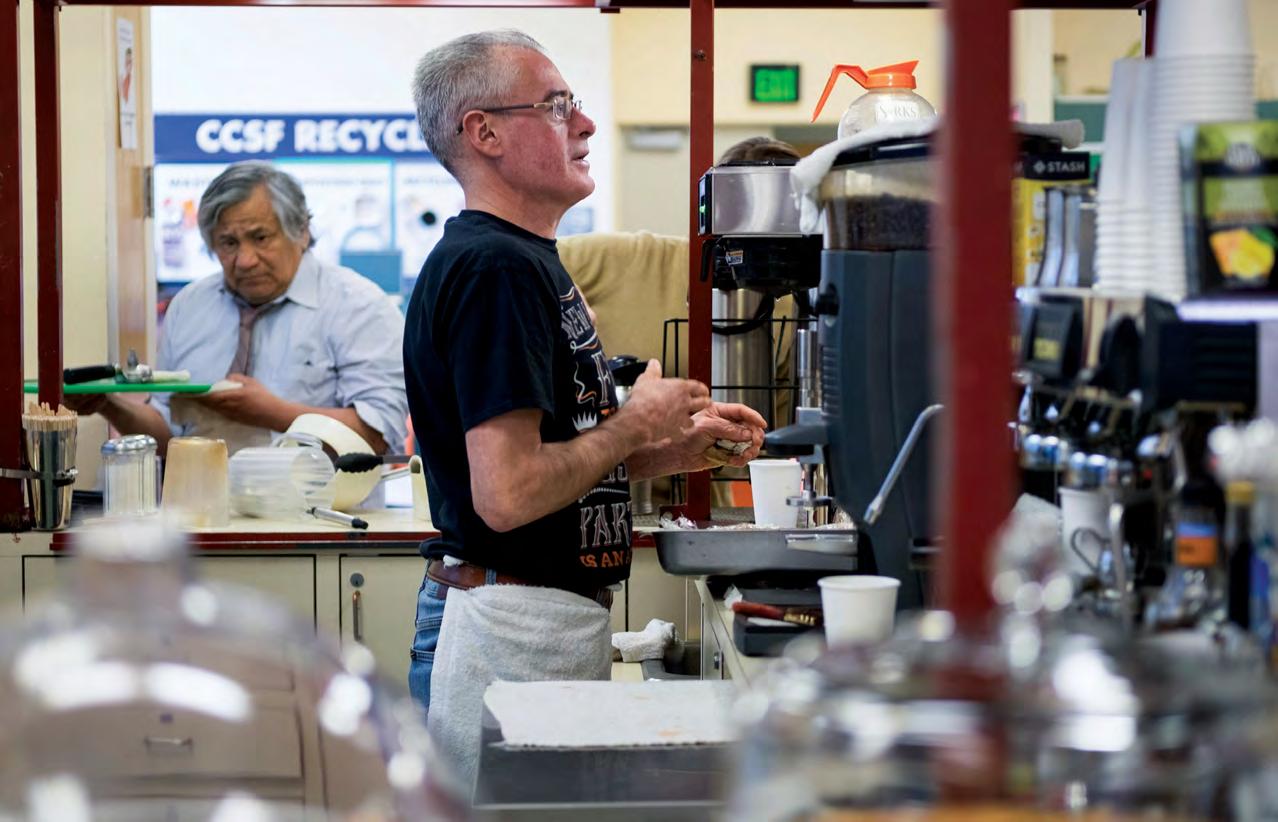 Alberto Campos, owner of Cafe de la Mission takes the last orders of the day while his friend Mario Lopez, left, helps clean up.
Alberto and Veronica Campos’ homemade flan is a favorite at Cafe de La Mission.
Story by Emily Huston Photographs by Emily Trinh
Alberto Campos, owner of Cafe de la Mission takes the last orders of the day while his friend Mario Lopez, left, helps clean up.
Alberto and Veronica Campos’ homemade flan is a favorite at Cafe de La Mission.
Story by Emily Huston Photographs by Emily Trinh
He jokes, “My major is eating here,” as he tucks into a pupusa revuelta, a traditional Salvadoran dish of masa stuffed with crispy pork, beans and
a tray of burritos each morning and Cafe de la Mission serves them topped with Veronica’s freshly-made salsa verde. The combined work of at least two cooks ends
out when we don’t open because they’re like, ‘Oh we’re not going to sell anything to you guys?’ and I have to say, ‘Sorry, we’re closed.’”
Some of their local vendors Alberto knows only on a first-name basis, like Mariano. He brings the flan, baked fresh each morning by his wife. “You won’t believe it,” Alberto says with a laugh, “but I never asked his last name.”
cheese then topped with queso fresco, peppers and fresh salsa.
Spanish is the prevailing language here, of the food and of the people. Growing up with seven brothers and five sisters in the state of Jalisco, Mexico, Alberto has been cooking since his grandmother used to kill the roosters by hand. “Like this,” he says, twisting his wrist with his fingers clamped to mime the unlucky bird’s neck being wrung dry.
Alberto moved to Oklahoma when he was 14, and found himself to be the only Spanish-speaking student in his school. The other boys asked him to teach them bad words in his native tongue.
Wanting to be closer to their cousins, Alberto and his brother Joel moved out to San Francisco a few years later. There Alberto found work as a dishwasher, then prep cook and eventually climbed the kitchen ladder up to line cook. No job lasted very long, as he flitted back and forth between his hometown of San Juan de los Lagos, in Jalisco, and San Francisco.
In his late 20s, at the behest of a friend, Alberto went to Los Angeles to cater at Universal Studios for Denzel Washington, Matt Damon and other Hollywood stars.
Nowadays, his menú del día serves a less glitzy clientele. Since there’s no kitchen, only a cramped 8-by-8 foot prep corner in Room 153, most of the food is prepared off-site, either by local vendors or by the Campos family in their San Bruno home. The dozen-item menu encompasses a cross-pollination of food traditions—Salvadoran, Dominican, Argentenian, Mexican—the portions are hearty and affordable.
Take, for example, the cafe’s popular breakfast burrito. It’s stuffed with a fair bit more than $4.75 worth of egg, chorizo, and potato. The South San Francisco restaurant Villa del Sol delivers
up a delicious mess on a paper plate.
“It’s a nice relationship,” Alberto’s son Jose Campos says of their local suppliers. “They help us, we help them. They freak
As Alberto and Jose heat up orders and squeeze fresh orange juice on a Thursday morning, the cafe’s soundscape contrasts staccato slams of the microwave door against the high-pitched whir of

 Alberto, right, and his wife Veronica Campos, left, work together at Cafe de la Mission at the Mission Center before the campuswide shut down in response to the shelter-in-place orders.
Alberto hands a pupusa to a student at the counter.
Alberto, right, and his wife Veronica Campos, left, work together at Cafe de la Mission at the Mission Center before the campuswide shut down in response to the shelter-in-place orders.
Alberto hands a pupusa to a student at the counter.
“You see the same faces usually, and then you start to know what they like. Sometimes they don’t even have to ask. They’ll just show up and we’ll do it.” — Jose Campos
their juicer. The doors open at 8 a.m. and orange plastic chairs spread around the cafe fill up fast.
In between orders, Jose complains of declining sales as a result of class cuts. The recent spate of slashed courses from the spring 2020 schedule has translated to a noticeable drop in students, faculty and staff eating at Cafe de la Mission versus semesters prior.
“Compared to two to three years ago, it’s pretty slow,” Jose says. “The rumor is that summer classes have gotten cut even more, so we don’t know if summer is going to be worth opening up.” Short-Term Interim Chancellor Dianna Gonzales announced in April that the summer session will operate entirely online to prevent the spread of COVID-19. Without a home on campus, the Campos family could be forced to seek out other ways to keep their business afloat.
“Maybe we’ll have to look for something independent, open up our own spot,” Jose continues.
Despite the ups and downs at this family-run cafe, Alberto remains a constant; the man behind every morning’s start and every night’s close.
As Jose tells it, he and his father wake up everyday at 6 a.m. to set up the cafe. Jose leaves around 2 p.m., but Alberto is there all day, shutting down at 8 p.m. to get home by 9 p.m. That’s a 15-hour day, for those doing the math at home. His only day off is Sunday.
“I’ve been working so hard here,” Alberto says, as he sits down after a long day on his feet. He greets customers as they settle around communal tables scattered about the room.
Jose speaks of the mutual familiarity that has formed between the Campos family and the Mission community over the past 12 years. “You see the same faces usually, and then you start to know what they like. Sometimes they don’t even have to ask. They’ll just show up and we’ll do it,” he says.
Since Cafe de la Mission doesn’t run ads, they depend on word-of-mouth to entice new customers. It also helps that there aren’t many places in San Francisco where you can get a tamal and a fresh churro for under 10 bucks.
At the end of the night, while Alberto wipes down the counters, Veronica turns with an expectant look and asks, “Do you want anything to eat, to drink?”
The casual touch of kindness is a reminder of the currency of relationships that cafe owners deal in and why a small business like theirs has lasted over 12 years in San Francisco. Here the food is something not to be sold, but to be shared—and there’s plenty of flan to go around.
At the time of publication, Cafe de la
Mission remains closed due to City College’s decision to cancel all on-campus classes. Instead of celebrating a storied 12-year anniversary, the future of this neighborhood mainstay is in limbo.
In the meantime, Cafe de la Mission cannot offer takeout like other restaurants because they depend on the college to be open. After speaking with Gregoria Nova Cahill, the interim dean of academic affairs at Mission Center, Alberto hopes to reopen in the fall 2020 semester.
 Alberto stands behind his technicolored cart where he can often be found greeting and serving customers. He hopes the cafe will be able to reopen soon.
Alberto stands behind his technicolored cart where he can often be found greeting and serving customers. He hopes the cafe will be able to reopen soon.
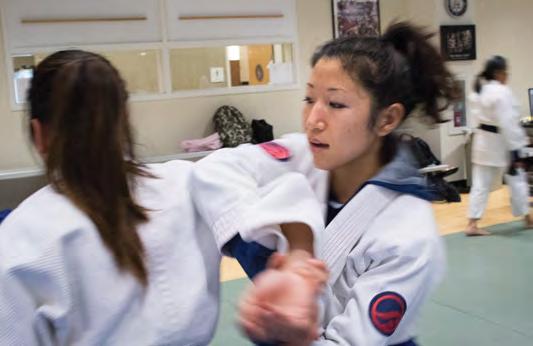 Story and Photographs by Abraham Davis
Story and Photographs by Abraham Davis
Athud breaks the din of sneakers squeaking across the polished gymnasium floor at City College of San Francisco’s Wellness Center. It’s the sound of bodies smacking padded mats in the dojo on the second floor where the judo and jiu jitsu club meets.
Thud after thud, students, each dressed in a traditional martial arts gi, pronounced “ghee”, throw one another to the ground. In pairs, they practice chokeholds and how to break their opponents’ arms.
This choke-and-get-choked, throw-and-be-thrown, is the give-and-take that creates strong friendships, connections and respect between club members.
“It’s the philosophy of maximum efficiency and mutual benefit. You learn to take care of the other and learn to work and respect
each other,” says Sharlyne Palacio, a City College student and black belt. She is also the sister of Mitchell Palacio, the founder and head instructor of the club.
Although technically a series of City College physical education classes focused on judo and jiu jitsu, Mitchell Palacio chose to call the classes a “club” to make it feel more inclusive. “I wanted to share that camaraderie that I had growing up,” he says.
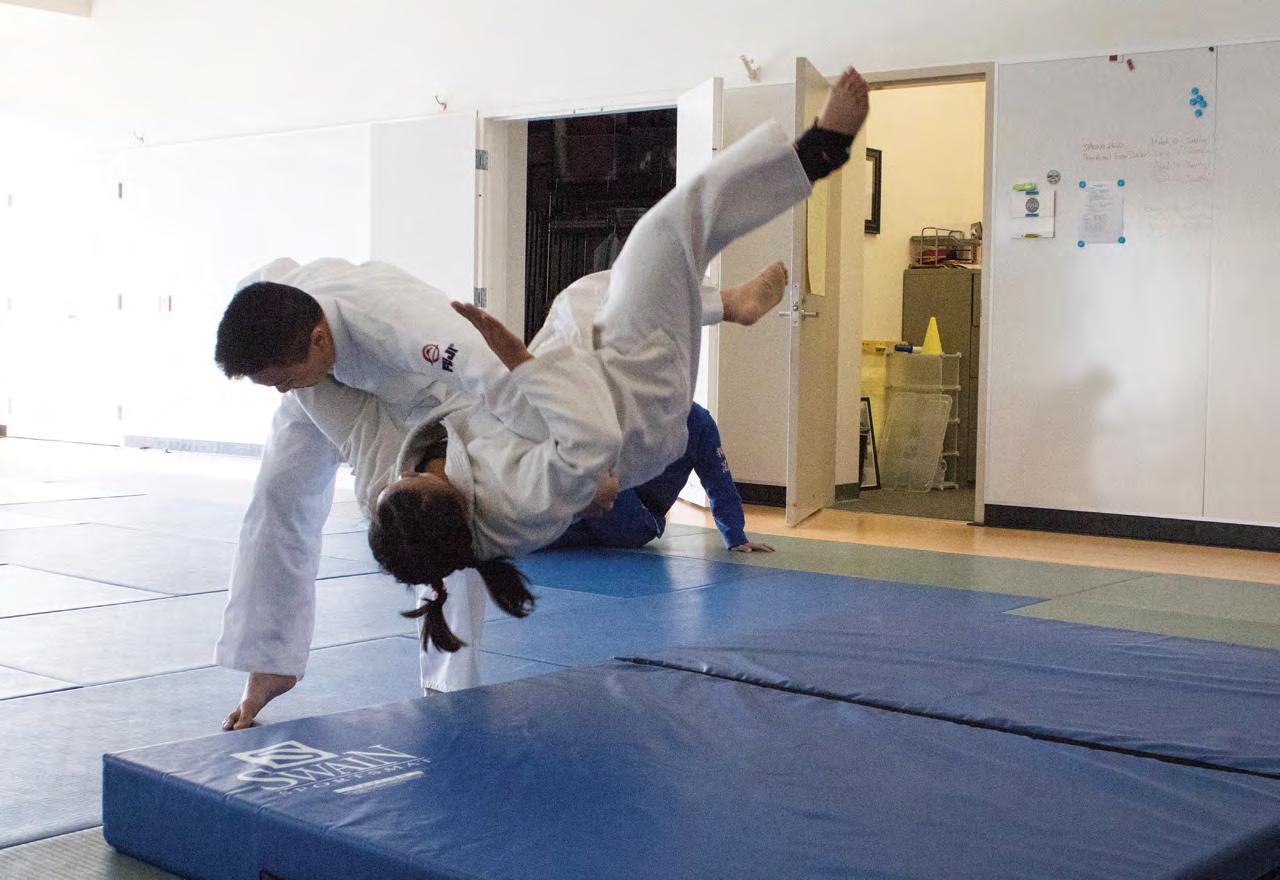 Judges Cantara, left, flips Rylie Borje during an extra Saturday morning practice held prior to an upcoming belt promotion for the City College judo and jiu jitsu club. Cantara and Borje are both white belts, which means they are beginners.
Stephanie Komura, right, grabs another student’s wrist while practicing a kimura during a Tuesday night class.
Judges Cantara, left, flips Rylie Borje during an extra Saturday morning practice held prior to an upcoming belt promotion for the City College judo and jiu jitsu club. Cantara and Borje are both white belts, which means they are beginners.
Stephanie Komura, right, grabs another student’s wrist while practicing a kimura during a Tuesday night class.
Palacio has a decorated background in martial arts. Not only is he the instructor, he was the president of California’s State Governing Body for Judo and a worldclass athlete who competed at all levels of national judo competition from high school to the Olympic trials.
Never one to boast, Palacio is quiet about his accomplishments. Even his son Cole Palacio, who also practices judo, doesn’t know how accomplished his father
is. “He just thinks I teach judo at City College,” Palacio says with a chuckle.
Palacio started at City College in 1978 as a tennis and soccer coach and taught one “pseudo-self-defense class” which developed into his current judo and jiu jitsu classes. He competed in his final Olympic trials in 1984 and opened the “club” two years later.
Judo and jiu jitsu both originated in Japan. Jiu jitsu was originally created by
Samurai, the military warriors of feudal Japan, as self-defense that didn’t require the use of weapons. During the mid 1800s jiu jitsu evolved into judo. Judo spread quickly all over the world, eclipsing jiu jitsu in popularity. Then, in the 1920s in Brazil, the Gracie family started to develop their own style which spread and evolved into “Brazilian jiu jitsu.” Today more people practice judo and Brazilian jiu jitsu globally than the older

Palacio attributes a significant increase in his club’s membership to the influence of the Ultimate Fighting Championship, UFC, events in recent years. The first UFC event, held in the mid 1990s had only 86,000 pay-per-view purchases compared to the upcoming 229th event boasting a record-breaking 2.4 million pay-per-view purchases, according to mixed martial arts website Tapology.
These days, more women sign up for the club. “Our female fighters are better than our males, in both judo and jiu jitsu,” Palacio says.
This may be due to their approach. He thinks women train to try and prove something to themselves, while men want to prove something to others.
“It’s more intrinsic,” he says of the women’s ambitions.
In judo and jiu jitsu, men and women
practice with each other, although they fight in separate categories during competitions.
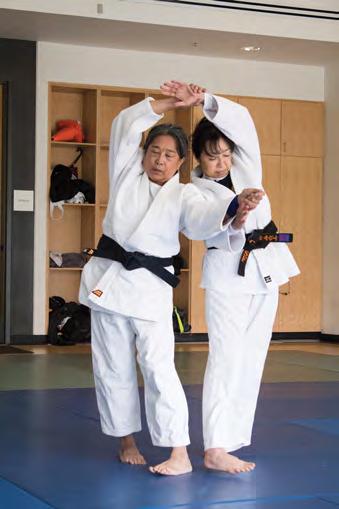
“It’s very empowering to practice against men,” says City College student Madison Auble, a jiu jitsu white belt, after a sweaty Tuesday night practice.
A white belt is the lowest tier belt, followed by blue, then purple, then brown and finally, the highest tier, the esteemed black belt. Technically the red belt is
 Above: Sharlyne Palacio who is Sensei Mitchell Palacio’s sister, left, and Minobu Shibuya, right, practice a junokata form, which is a formalized throw, during a Saturday morning practice session. Sensei is a traditional word for teacher in the martial arts.
Left: Palacio, standing, back left, watches his students warm up their hips before the intermediate judo class.
Japanese jiu jitsu.
Above: Sharlyne Palacio who is Sensei Mitchell Palacio’s sister, left, and Minobu Shibuya, right, practice a junokata form, which is a formalized throw, during a Saturday morning practice session. Sensei is a traditional word for teacher in the martial arts.
Left: Palacio, standing, back left, watches his students warm up their hips before the intermediate judo class.
Japanese jiu jitsu.
the highest tier, but that is reserved for grandmasterswho who have dedicated a minimum of 50 years to mastering the art.
Auble tried jiu jitsu for the first time last fall, after browsing the list of available physical education classes. “Not only did it sound bad-ass, it also sounded physically and mentally stimulating,” she says.

Auble competed in the California State Championship Judo Tournament in fall 2019 and came back this spring for more. She now considers jiu jitsu a big part of her life.
“It’s so fun, every single practice you learn something new and advance a little more,” she says.
Graphic design major Jhoney Chong began her martial arts journey with the club when she moved to the U.S. from Panama two years ago.
She has since earned her brown belt in judo and is working towards her blue belt in jiu jitsu. Now she mostly trains at Magalit Brazilian Jiu Jitsu Gym in San Francisco, but she still attends the City
Palacio’s class forms a circle to watch him demonstrate another move called a kimura. Palacio holds his student’s wrist while looping his own arm through the student’s to grab his own wrist. Then
big pretzel. After he shows them a few times, a mix of all ages, sizes, genders and backgrounds randomly pair off and get to it.
College club on Tuesday and Thursday nights to help out Palacio.
Most of Chong’s friends in her new home of San Francisco are people she has connected with through judo and jiu jitsu. Chong believes the process of learning, training, competing and helping each other creates a strong community.
“Sometimes I know something more than someone else, sometimes someone else knows more than me, so we come together and get better with each other,” she says.
Chong loves how many women participate and thinks it takes courage for them to grapple in a male-dominated sport.
Age isn’t a factor either. Sharlyne Palacio, 69, and Minobu Shibuya, 55, are lifelong learners who take the judo class offered at City College. They met in the judo class and have been good friends ever since.
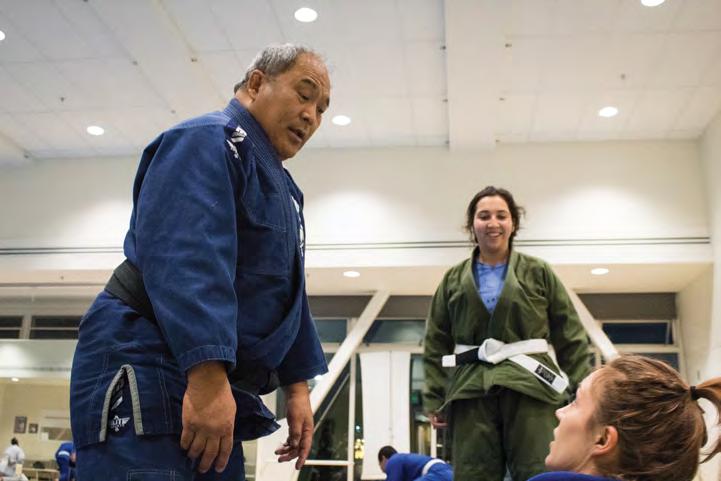
Palacio pulls his elbows close to his belly, putting pressure on the student’s shoulder. To the untrained eye it looks like a
They teach, encourage, and laugh together, making their dojo so much more than a room full of random people practicing self-defense. It represents everything that makes City College succeed: A diverse community built by people committed to helping each other. Together they foster skills that will serve t hem beyond the dojo as they move forward in life.
Students practice a classic move called an arm-bar during a beginner judo and jiu jitsu class. Palacio, left, advises white belt Madison Auble on how to perform an escape technique.“It’s the philosophy of maximum efficiency and mutual benefit. You learn to take care of the other and learn to work and respect each other.” — Sharlyne Palacio
Early morning fog swallows Mission Street while Nikki Phillips waits for her 49-bus. She hopes there is a place for her to sit. “When you sometimes have to pass a bus by because there’s not a seat for you, it makes it harder,” says Phillips, whose degenerative joint disease, a form of arthritis, makes her daily commute more complicated than most. She heads to City College of San Francisco’s Ocean Campus to attend 14 credits worth of classes. Phillips, 48, sets a high bar, working towards two associates degrees, one in Anthropology and one in Psychology. She is a testament to City College’s commitment to educate all members of the San Francisco public, regardless of age or ability. She struggled for years with her disabilities, but had to be officially diagnosed to qualify for assistance. In 2008, Phillips

was diagnosed with an anxiety disorder, bipolar disorder, and Post Traumatic Stress Disorder, PTSD. Thanks to City College’s Disabled Students Programs & Services, DSPS, Phillips moves forward with her education, seemingly without a hitch.
Life wasn’t always this good. Her childhood in Denver was tarnished by a toxic home life, punctuated by her mother’s abuse. By the time Phillips was 12 her mother was forcing heroin on her. She left home to save herself. “I was big enough and I was old enough, so I left,” she says.
In those first three months on her own, Phillips suffered from substance withdrawal. Her grandmother got her an apartment in Denver, and she began splitting time between there and her father’s home.
Nikki Phillips heads to her morning Statistics Class at City College. Phillips attends school full-time and works as a tutor while she manages multiple physical and mental disabilities, including a degenerative joint disease.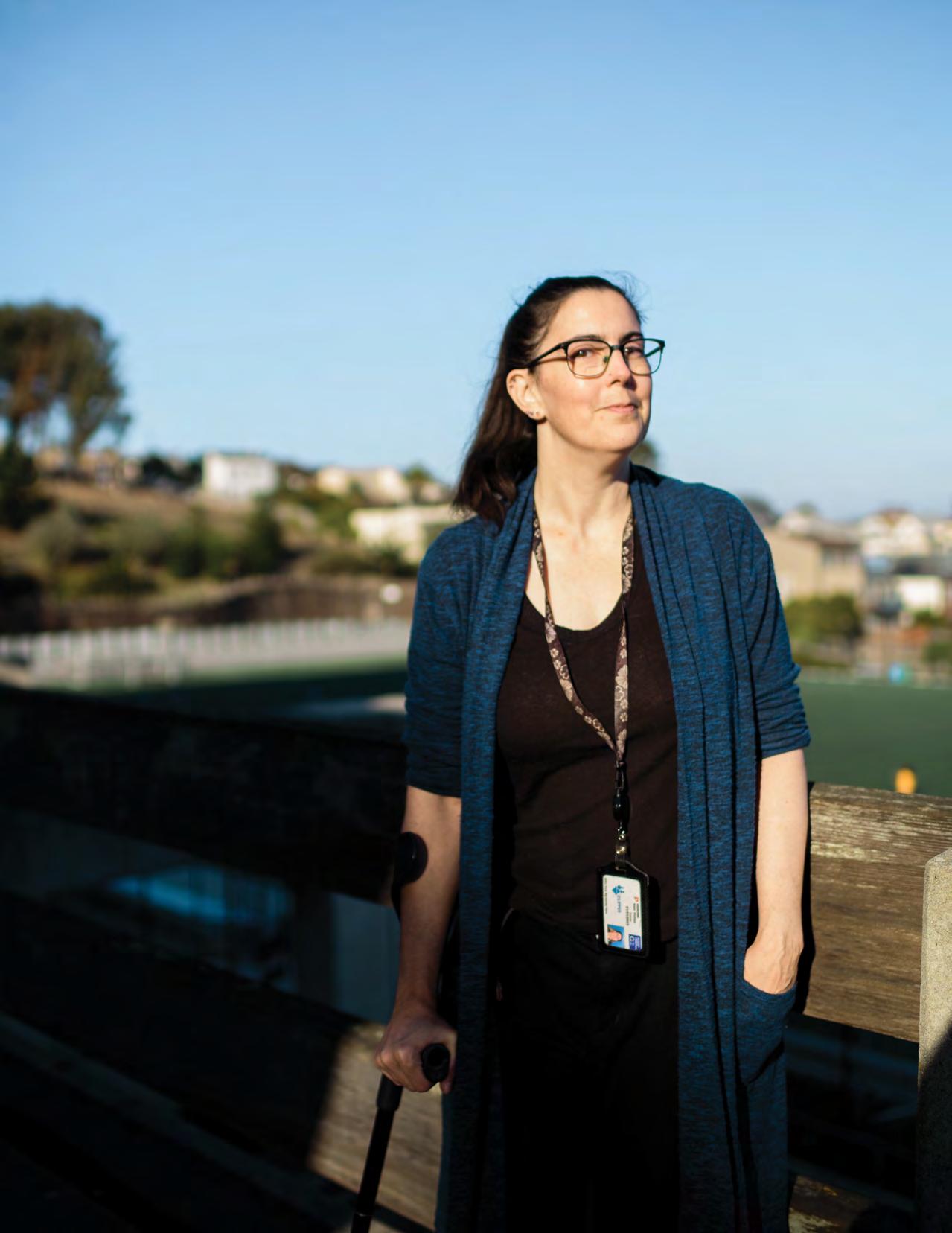
After she regained her health she was determined never to let hard drugs dictate her life again. It’s this grit that defines Phillips, not her abusive past. “I cleaned myself up and I’ve never touched the stuff again,” she says.
She continued to go to school and worked at a grocery store to support herself. Phillips graduated high school in 1990.
On Christmas Eve, 1991 at age 19, Phillips married her childhood sweetheart, Emory Phillips. “It’s a decision I have never regretted,” she says.
Just two months after they wed, they were excited to start fresh with a cross-country move from Colorado to Shreveport, Louisiana where Emory Phillips had an opportunity to go to college. However, their optimism faded as they ran through their limited savings. They were homeless within weeks. “Nine months later we came running and screaming back to Colorado,” Phillips says. They settled down closer to family. Over a decade later, they decided to try their luck in San Francisco, but the
high-priced Bay Area was no more forgiving. In 2002, they found themselves homeless again. “We lived in the park, we stayed up on Hippie Hill,” says Phillips, “I carried more than my own body weight up that hill every night. That’s part of the reason why my body has given up on me.”
Phillips has a knack for picking things
anxiety disorder, PTSD, and bipolar disorder. The pain and stiffness caused by her degenerative joint disease, which had just been diagnosed, progressed to a point that she had to stop working and rely on a walker and disability payments.
Five years after they reconnected, her mother died. Phillips was devastated, “I was looking closely at my own mortality,” she says.
up quickly and found work. She was hired at a hostel and then worked for a theatrical lighting company, called Phoebus, which was her favorite job. “I started as the receptionist there and I ended up working on movies,” Phillips says and chuckles as she recalls her days on set for box-office smashes like “Transformers” and “Batman Begins.”
Her mother reached out while in therapy and drug rehabilitation in 2012. They reconnected and Phillips forgave her.
Phillips was in treatment too, for her
Just a short time later, during the next election cycle, Phillips saw Free City College on the ballot and voted for it. “I got curious how it was free, and so I went online and tried to check it out. Three months later I get this email that says ‘it’s time to register,’” she says.
Phillips likes to learn, but for years didn’t think higher education was a possibility for someone like her. She was unaware of the extensive resources City College offered and she did not think to ask.
She was still reeling from her mother’s death, so Emory Phillips looked into resources at City College and found the DSPS program. She remembers him
 Nikki Phillips, right, and her husband Emory Phillips, left, say goodbye after he came to visit her at her office on Ocean Campus one afternoon.
Nikki Phillips, right, and her husband Emory Phillips, left, say goodbye after he came to visit her at her office on Ocean Campus one afternoon.
“Today we recognize that not all disabilities are physical, and many are not visible.” — Natalie Cox
Nikki Phillips, center, sits back by the windows while she attends a statistics class taught by Dr. Ramona Coates, far right. asking, “Well, are you gonna go?”

They visited DSPS together. “I really wasn’t sure how I was going to do this,” Phillips says, but with support from her husband and DSPS, Phillips made the leap and enrolled at City College in the fall of 2018.
The opening of City College’s DSPS program in 1977 established sustained and crucial support for over 3,000 students every year. Additional aid came with the passing of the Federal Americans with Disabilities Act, ADA, in 1990.
The intention of the ADA was to offer protections to individuals with disabilities that are similar to those provided on the basis of race, sex, national origin, age and religion. Nowadays it is common to see students like Phillips using accessible ramps to get to classes, or attending courses accompanied by an American Sign Language, ASL, interpreter, but things weren’t as easy for disabled students a few decades ago.
Prior to the passing of the ADA, a
disabled person in the United States faced innumerable barriers in their day-to-day experience that an able-bodied individual would not think twice about. People who use walkers or wheelchairs could not easily access public infrastructure, but now the ADA requires all public buildings and transportation to offer ramps and elevators that can accommodate them.
Before the bill passed, disabled City College students faced an uphill battle. Elevators routinely did not work, ramps were slow to appear, and change was held up due to a lack of local initiative. The ADA created a new and level playing field for people like Phillips.
Today, City College offers a variety of resources through DSPS. According to DSPS Department Chair Olga Galvez, they make sure everyone with disabilities feels welcome and receives personalized treatment.
“We work with students on what areas they might need support in, and which accommodations might be appropriate to assist them in being successful in their
classes,” Galvez says.
DSPS counselors focus first on students’ fundamental needs for academic success. Each disabled student’s formula is unique. DSPS counselors assess more than academic ability when searching for solutions. “Sometimes what a disabled student needs is to take less classes to perform well,” Galvez says.
Students have access to extended testing times, quiet testing environments, Braille translations and ASL interpreters. Out of school for over two decades, Phillips knew she would need DSPS to succeed. “I receive special permission to record my classes. I have access to a scooter, and longer times on my tests if I need it,” she explains.
She is also granted special consideration for days she may miss due to her mental illness.
“I do struggle sometimes,” Phillips admits. But with the support and resources at DSPS, she is thriving. She says it’s not just because of DSPS, but also her instructors.
“If the teachers and DSPS weren’t who
they were, I would not be here. They always have consideration for me,” Phillips says.
Some of her instructors have played an extraordinary role, giving her all she needs to perform well, but one in particular stands out, Anthropology Instructor Natalie Cox. Cox has been a teacher, mentor and friend to Phillips.
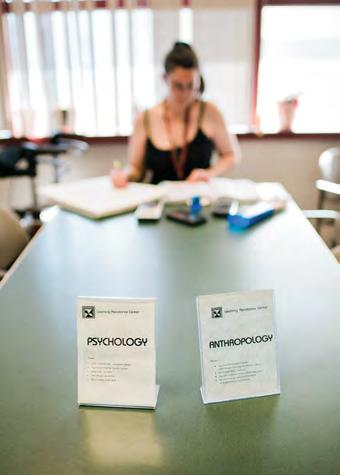
“She is the best teacher that I have had since kindergarten,” Phillips says.
Cox is acutely aware of how important it is for instructors to accommodate disabled students. In her two years teaching and 17 years as a tutor for disabled students, including Phillips, Cox has witnessed many positive changes.

“Today we recognize that not all disabilities are physical, and many are not visible. Chronic illnesses, autism, psychological issues such as bipolar disorder and learning disabilities— these are all conditions which can and should be accommodated to promote student equity and success,” Cox says.
“I have known Nikki for two years now. She went from being my student to being someone I informally mentor from time to time, and I still check in with her regularly,” Cox says.
When they first met, Cox saw her enthusiasm. “It was unmatched by her peers, and she had the ability to critically connect with course concepts,” Cox says.
Limited motion doesn’t stop Phillips from being an integral part of City College. She tutors other students in statistics, psychology and anthropology, for little to no compensation.
Phillips is on track to finish her two associate degrees and graduate this spring. Her plan then is to take her talents and charisma to San Francisco State University. She hopes to triple major in psychology, anthropology, and her newfound passion, statistics.
One morning, around 11 a.m. she is in Batmale Hall, plotting an equation sprawled across a white board for a half-dozen statistics students in need of help.
Without her walker, Phillips shuffles across the room to get a closer look at the board. She demonstrates how to solve the equation, but it was still unclear to one student. “You’re right! I did it wrong,” Phillips admits with another chuckle. Her light-hearted personality keeps the tutoring fun, regardless of the material.
When asked what influences her academic choices, Phillips says she likes the behavioral sciences because, “I don’t understand people, and I find them fascinating.” How she came to her newfound love for statistics is just as endearing.
“I looked around the room and realized that nobody else was getting it and I started to cry. It was tears of joy, but I was sitting in the classroom and crying because I understood it.”
Nikki Phillips waits for students to tutor in anthropology and psychology at the Learning Assistance Center. Nikki Phillips, center, tutors Delaney Bradix Lofton, left, and Dakota Boyd, right, in statistics.Market Street bustles on a typical afternoon in February. Crowds rush the sidewalks and packs of cyclists whir by. It’s Friday and workers are anxious to call it a day. An electric MUNI bus hisses to a stop, fills up and pulls out into its dedicated red lane.
It is “rush hour”, but something is missing. There isn’t a single passenger car on San Francisco’s main thoroughfare.
At the end of January, San Francisco’s busiest street became car-free as a part of the Vision Zero program, with a goal to eliminate traffic fatalities and injuries by 2024.
Overseeing various safety improvements within the Vision Zero program is the San Francisco Municipal Transportation Agency, SFMTA, Livable Streets unit, a
part of their Sustainable Streets division. Sustainable Streets oversees the city’s transportation infrastructure—whether it’s for public transit, bicycles or pedestrians.
With 500,000 pedestrians on Market Street daily, and hundreds of cars passing through during rush hour, potential for accidents was high. SFMTA reports that in 2018, there were 123 injury collisions along the roughly 18 blocks of Market Street between Octavia and Steuart Streets. City officials hope the new restrictions will reduce these incidents.
“It’s finally happening,” says Livable Streets Senior Planner Nick Carr who attended discussions for a car-free Market Street almost 20 years ago.
SFMTA and other collaborating agencies refer to the new and improved

Market Street as “Better Market Street.” However, it is still a work in progress.
Director of Livable Streets, Jamie Parks, says, “The initial data shows that it’s working very well,” in spite of the magnitude of the project.
After implementation, with no cars in their way, MUNI vehicles breezed through a large stretch of downtown, getting people to work faster and possibly even attracting new riders, although so far there is insufficient data to confirm this.
The COVID-19 pandemic has left Market Street truly car-free since March 17, due to Mayor London Breed’s shelter-inplace order.
Prior to the shutdown, things were looking up for Better Market Street. Rushhour loading restrictions for six-wheel
An F-train passes a bus on Market Street prior to the shleter-in-place order. The main corridor has been closed to private vehicles since the establishment of a new ordinance that went into effect on January 29, 2020. Story by Eleni Balakrishnancommercial vehicles were implemented on Market Street in January, and more than 100 new passenger and commercial loading zones were put in place along the cross streets.
“In the first few weeks after Market Street went car-free we saw significant increases in bike ridership, and reductions in transit delays and collisions,” says SFMTA Chief Spokesperson of Media Relations Erica Kato. “Preliminary data showed that bike volumes increased by more than 25%, and transit travel times improved by up to 12%.”
“Unfortunately, our plan to collect more extensive data this spring was put on hold due to COVID-19 and the shelter-in-place orders,” Kato adds.
Plans to enlarge crosswalks and street corners to create new pedestrian “safety zones” are in the works. Infrastructural changes such as roadway repaving, upgrading traffic signals, and replacing Muni F-line tracks and overhead cables are tentatively scheduled to debut in the summer of 2020, but COVID-19 may impact that schedule.
Cyclists noticed huge improvements in their downtown commutes with the absence of cars on Market Street. “I love it!” says Jean Kao, president of the San Francisco Bicycle Coalition’s Board of Directors, “It feels like a bike party every day!”

Kao attends City College of San Francisco for occasional classes in her spare time, and commutes from the Castro District to the Financial District daily. She works at Populus, a tech company dedicated to helping cities monitor their shared transportation services, including bikes, scooters, and cars. Since bicycles still share lanes with buses, she feels Market Street is “not as safe as it could be,” but it’s definitely better.
City College student Hiya Swanhuyser says her husband’s new Market Street bicycle commute is similar to “what everyone says,”there is still a lot of vehicle traffic. She suggests the city work toward building bicycle-only streets, where buses,
rail lines and poor asphalt are a thing of the past.
Longer term plans for Market Street do include wider bicycle lanes, but bicycle-only streets are a ways away.
On Market at 10th Street, which is the last block eastbound where private vehicles are permitted, cars line up sequestered in a turn lane, as if being sent off for punishment. Ride-share cars like Uber and Lyft line up too, because they must adhere to the same rules. One bold Lyft driver sneaks a rider in; the door slams and they hastily drive off as the light turns green.
Melandro Monterola, a finance student at City College who drives for both Lyft and Uber, says he does this all the time.
“It’s risky but when it’s a red light, (riders) tend to just hop out,” he says.
While the new changes to Market Street might have been expected to further curb Uber and Lyft’s influence, Monterola, who has been a driver since late 2016, doesn’t think much has changed. “Even before, Market Street was off-limits for dropoff and pickup,” he says.
Now that the street is car-free, he thinks things have improved and believes most drivers would agree with him. “Driving on Market Street was scary … bicyclists and pedestrians everywhere. Now I don’t have to drive on that street anymore. It’s kind of a relief,” he says.
Uber and Lyft have caused congestion throughout San Francisco for years, but
A cyclist passes a taxi on the east end of Market Street on a Monday afternoon in early March prior to the shelter-in-place order.“It feels like a bike party everyday!” — Jean Kao

recently, alternative forms of transportation have sprouted up, like for-rent two-wheelers some call “shared micro-mobility” vehicles. These new modes of transportation are convenient, economical and environmentally friendly.
Companies like Scoot and Lime provided 84 million trips in 2018, which is double that of the previous year, according to the National Association of City Transportation.
Currently, taxis and commercial vehicles can still drive on Market Street. The taxi industry has struggled to compete against new alternatives, and hopes the elimination of ride-sharing vehicles on Market Street will boost business.

Back on Market, a bright yellow taxi rolls by slowly, as if on display, but the back seat is empty. The driver peers out the window, scanning the sidewalks for a rider.
Taxi driver Daniel Habtu typically logs 45-50 hours per week. He drives through downtown San Francisco every day.
While occasional customers have hailed Habtu’s cab from Market Street, he says the benefit is “not massive.”
The slight added convenience just doesn’t seem worth it to most riders.
“If you close Market Street, they can walk to Mission and call (a Lyft or Uber) from Mission. It’s half a block.” Habtu says.
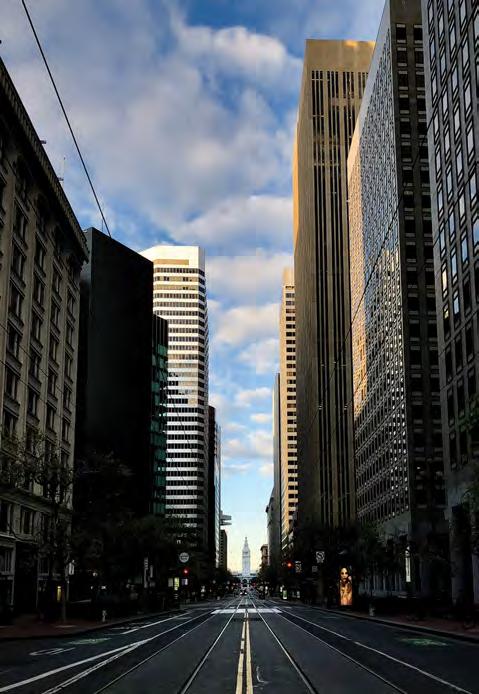
Uber and Lyft riders can clearly see within the apps that taxis are more expensive. “We’re not in the competition; the taxi business is lost already. You’re not gonna get it back by closing the streets,” he adds.
And it will likely get worse for taxis. There are plans to convert the existing bus-and-taxi-only lanes to bus-only lanes and extend them from Ninth to Main Street, a 1.5 mile stretch through the majority of downtown San Francisco. Only MUNI, pedestrians, cyclists and other non-motorized two-wheelers will have access to Market Street.
Habtu agrees that a car-free Market Street is a welcome change for some, “the bikers, they’re
A lone taxi approaches Market Street 11 days into the City’s shelter-in-place order. The main stretch of Market Street has been closed to private vehicles since Jan. 29, but taxis are still allowed to drive there, for now. Market Street, already closed to private vehicles, appears, deserted five days into the City’s shelter-in-place order.Passengers ride the eastbound Market Street F-train at the start of rush hour in February. winning,” he says without resentment.

Habtu had hoped to resume classes soon at Laney College in Oakland, but drove for Uber and Lyft instead to pay his bills. However, like Monterola, he’s not driving at all for the time being. The COVID-19 pandemic threw a wrench into all of his plans and Habtu is staying home, like much of San Francisco.
as effective ways to get around. High-speed rail systems connect cities in Asia like Beijing and Shanghai. In the city of Jakarta, twice as many people ride motorbikes than drive cars daily.
There were once large networks of urban streetcars in cities like Indianapolis and Los Angeles, but the Great Depression destroyed most private transit companies. By the mid-1900s, fervent lobbying from the burgeoning auto, bus and oil industries, led to the dismantling of many streetcar lines and today’s staunchly car-centric way of life.
Lately San Francisco and other urban centers started shifting toward policies that push aside gas-powered cars in
favor of cycling, e-scooters and public transportation.
Cities like New York, Toronto and Oslo have adopted their own versions of Vision Zero, a movement first implemented in Sweden in 1997 to end highway fatalities.
Last year, New York City essentially turned 14th Street, one of the most congested routes in Manhattan, into a “busway” where private vehicles are only permitted to drive onto the street for quick pickups and dropoffs. The year before, Toronto put similar restrictions in place on its busy King Street, making huge improvements to the average travel times of streetcars there.
In New York fatalities decreased, but injury collisions increased. Oslo saw no pedestrian and cyclist fatalities in 2019.
Kao and Habtu agree there is still a long way to go, but Vision Zero, Livable Streets and Better Market Street are the start of a fundamental change.
Until everything came to a halt in March, Market Street at a quick glance didn’t look incredibly different after the restrictions began in February, than it had in early January. Cyclists still cruise by, but with a little more breathing room atop bright red and green painted lanes and the F-train still jingles toward the Ferry building.
But now traffic is non-existent. San Francisco is on hold, and so is Better Market Street.
MUNI typically struggles to keep wait times reasonable. Two huge systemwide breakdowns occurred in the past year, including a 10-hour shutdown in April 2019, which resulted in the Mayor London Breed’s push for SFMTA Director Ed Reiskin’s resignation. The second breakdown occurred in early March 2020, shortly after Jeff Tumlin took over the agency. Now, in a pandemic, MUNI is running on a reduced schedule until further notice.
San Francisco is beginning to emulate other cities around the world where cars enjoy far less prominence. European cities like Copenhagen and Paris emphasize walking, cycling, and public transportation
 Light traffic gives way to a clear view of the Ferry Building as seen from inside an F-train.
Light traffic gives way to a clear view of the Ferry Building as seen from inside an F-train.
“Driving on Market Street was scary … now I don’t have to drive on that street anymore. It’s kind of a relief.”
— Melandro Monterola
Photographers Emily Trinh and Keven Kelleher needed to get out and stretch their photojournalism muscles during the pandemic. “How do we make peace with this?” they wondered. “We were looking for catharsis,” says Kelleher, so they ventured outside from their apartment near Ocean Beach and wandered the neighborhoods of San Francisco to ask people what,
if anything, has been the silver lining for them during this shelterin-place experience. The photographers generously offered a sample of their project with Etc Magazine. For the sake of their vision for the series and also to respect people’s privacy, Trinh and Kelleher chose not to ask for last names.


To view their ongoing project visit www.kemilyvisuals.com
“I’ve come to terms with the fact that I can’t control what’s going on out there, but I can control what’s going on with me. I have a workout pole in my room and I can really go ham with training.”
— Hilary, former City College of San Francisco student, Sunset District
“It slows me down for all the things I’ve taken for granted … like this, just talking to people more. And I’ve been appreciative of friends reaching out to me.”
— Andrew, City College of San Francisco student, Civic Center
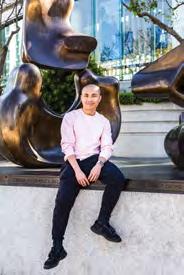
“Working on the garden, I’d be out here anyway but now I have much more time to really work on it.”
— Dan, San Francisco resident, Mission District
“Nothin’s slowing me down, no traffic, and nobody’s out here bothering me. It’s great. I can just do my job and if I do see someone, I say hello and wish them the best.”
— Elmer, Mission District, Postal Service Worker


“The environment. I was with my auntie at Lake Merced and noticed the air quality’s a lot better. Everyone needs do their part so it can stay like this.”
— Michelle, San Francisco resident, Civic Center

“I try not to think about all that. I have my job, I like it, and I just keep moving forward. On my days off, I like cooking.”
—“To see people working together as a community and keeping infection rates low. In just three days we’ve seen a significant decrease. It’s been great to be here and a part of that.”
 — Favian, Orthopaedist, San Francisco General Hospital
— Favian, Orthopaedist, San Francisco General Hospital

“The simple fact that we get to spend so much time with Teddy.” Teddy is their first dog.
— Bryan, Stephanie, and Teddy, San Francisco residents, Sunset District


It’s definitely been weird. Growing up white in a first-world country has insulated me from experiencing a lot of the instability and injustice that’s present in the daily lives of others. So when the pandemic came along, it reminded me that our hold on life is tenuous. It’s an easy thing to understand intellectually, but quite another to feel it emotionally. When something threatens your life, it wakes you up.
Wearing a mask for trips to the grocery store drives home the point. It’s like being in a movie about an apocalypse. My glasses fog up and I hear my breath, even feel it against the confines of my mask. This is my reality now. At the beginning of the pandemic, I didn’t wear a mask. Now I feel a mixture of suspicion and irritation whenever I see someone else who’s not wearing one. I feel threatened by their choice.
I haven’t known anyone who’s caught the virus. I thought I had a slight fever one day, and my wife experienced that too. Since then I’ve been sleeping on the couch and using a different bathroom, so that if one of us gets it, hopefully the other one won’t. Those symptoms only lasted for an hour or two and haven’t returned; we both feel fine. That said, we’re isolated and do the social distance dance when we go out and about.
I’m a creative person, so I’ve been creating quite a lot during the pandemic. Art helps me process what’s going on around me and gives me a way to articulate a response. My photography is multi-exposure and abstract now, including unlikely pairings from both film and digital sources. Music I’ve recorded lately has featured no real instruments, just random sounds recorded on my
phone and processed in my studio. My poetry has words all over the page, shifting back-and-forth like a drunk python. Is this the shape the virus has taken on in my thoughts?
Amidst it all, I’m grateful to have our dogs to walk. They get me out and about three times a day, keeping me from getting stir crazy while I get some exercise—a semblance of routine and health in an uncertain time.

Yvonne, Bay Area resident, Civic CenterTop row left to right: Kevin Kelleher and Emily Trinh, Instructor Jessica Lifland, Meyer Gorelick, Abraham Davis. Second row left to right: Jasmine Castillo, Ashley Ornelas, Daniel Murphy, Eleni Balakrishnan. Bottom row, left to right: Fran Smith, Jennifer Yin, Steven Ray, Diana Flores Guzman. (Photograph of screen by Jessica Brandi Lifland for Etc Magazine)
To register for courses go to www.ccsfjournalism.com
For more information call (415) 239–3446 or email etcmagazine@mail.ccsf.edu
Jour 21: News Writing and Reporting
76162 001 Lec. T R 11:10 – 12:25 p.m.
HC 206
3.0 units
Gonzales
Techniques of newspaper reporting, developing and writing a news story, training in information gathering and interviewing sources.
PREREQ.: ENGL 93 or ENGL 95 or ENGL 88 or ENGL 88A or placement in ENGL 96 or ENGL 88B
Jour 22: Feature Writing
72111 551 Lec. T 6:10 – 9:00 p.m.
3.0 units
Mission Center/Rm. 217 Gonzales
Fundamentals in feature writing for magazines and newspapers with special emphasis on profile and interpretive news features. Practical experience in interview and in-depth research techniques. Training in how to write a freelance story for publication.
PREREQ.: ENGL 93 or ENGL 95 or ENGL 88 or ENGL 88A or placement in ENGL 96 or ENGL 88B
Jour 24: Newspaper Laboratory
76882 001 Lec. M W F 12:10 – 2:00 p.m.
BNGL 615
3.0 units
Gonzales
Beginning newspaper laboratory course focused on the publication of the college newspaper The Guardsman. Provides a practical understanding of the various elements involved in producing a newspaper. ADVISE: JOUR 21. CSU
Jour 26: Fundamentals of Public Relations
79263 001 Lec. T R 09:40 – 10:55 a.m.
HC 204
3.0 units
Gonzales
This course prepares students to create an effective public relations campaign that includes writing media releases, “pitch” letters, public service announcements, managing media outlets, coordinating mailings, and designing leaflets and posters, as well as setting up a news conference. CSU
Jour 29A: Intro Magazine Editing & Production
79264 551 L/L M 6:15 – 9:15 p.m.
Mission Center/Rm. 217
3.0 units
Lifland
An introduction to the process of creating a magazine publication. Students work as part of a staff of writers and photographers, focusing on writing and photographing feature stories suitable for publication in the campus magazine.
ADVISE: JOUR 21 or JOUR 22 or JOUR 37
Jour 29B: Interm Magazine Editing & Production
79266 551 L/L M 6:15 – 9:15 p.m.
3.0 units
Mission Center/Rm. 217 Lifland
An intermediate exploration into the process of creating a magazine publication. Students work as editors focusing on editing content suitable for publication in the campus magazine. They participate in the editorial and production process and develop the skills required for publishing a campus magazine.
ADVISE: JOUR 29A
Jour 29C: Adv Magazine Editing & Production
79265 551 L/L M 6:15 – 9:15 p.m.
3.0 units
Mission Center/Rm. 217 Lifland
An advanced exploration into the process of creating a magazine publication. Students work in management positions focusing on leading a staff in producing content suitable for publication in the campus magazine. They facilitate the editorial and production process and develope the skills required to manage the publication of a campus magazine. ADVISE: JOUR 29B
Jour 31: Internship Experience
2.0 units
72312 001 Exp HOURS ARR BNGL 615 Gonzales
Supervised on-campus or off-campus employment in a branch of journalism or a closely allied field.
ADVISE.: JOUR 24, Repeat: Maximum credit: 4 units
Jour 37: Intro to Photojournalism
76939 551 Lec. W 6:10 - 9:00 p.m.
3.0 units
Mission Cenrter/Rm. 217 Lifland
Emphasizes concepts of photojournalism such as news and feature photography. Assignments will involve photographing people and visual storytelling at a level appropriate for publication such as in campus publications. Access to Single Lens Reflex (SLR) digital or film camera required.
ADVISE: PHOT 51 or demonstration of equivalent knowledge. CSU